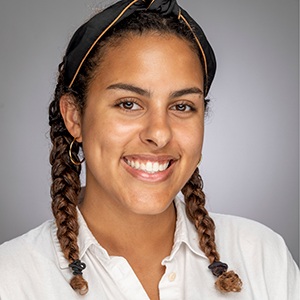19 tips for giving an effective talk
As scientists, we communicate our work in many ways. We publish peer-reviewed manuscripts, we write reviews and books to summarize the state of our fields, and we give oral presentations at seminars and conferences. Each of these formats presents unique challenges; however, all of them require intense editing and feedback from mentors and peers.
In this article, I’m sharing tips on how to prepare your talk, tips about your slides (design and structure), and tips on presentation. Discover BMB is less than a month away — it’s time to get ready to present your science.

I am a fifth-year Ph.D. candidate at Vanderbilt University, and during my time in graduate school, I’ve learned many lessons about how to give an effective talk — often by giving an ineffective talk and receiving much-needed feedback. At first, I was uncomfortable hearing critiques, but I learned that the purpose of constructive criticism is to help me grow; when someone gives me feedback, it’s because they care about my success.
By being receptive to constructive feedback, I learned that I tended to overexplain the technical aspects of my data without highlighting the broader impacts of the findings, I used brightly colored slides that were distracting, and I spoke too quickly. Thanks to this feedback, and after giving dozens of talks for different audiences in various settings, I learned to correct these issues.
Now when I give a talk, I often get feedback from the audience about how clear and engaging I was, so I want to share what I’ve learned about how to give an effective oral presentation.
The following list includes tips sourced from a tweet written by Tessa Davis (@TessaRDavis), a presentation coach who shares helpful advice, and from a YouTube video I created, “30 tips on how to give an effective talk,” which is a culmination of the lessons I’ve learned about presenting during my time in graduate school.
I’ve learned that an effective oral presentation is clear, compelling and accessible and establishes a convincing argument supported by empirical data, all constrained by a time limit. As I mentioned at the outset, an effective presentation requires a lot of practice, feedback from trusted peers and editing.
Preparation
- Create your presentation with your audience in mind. If you’re talking to a room of M.D.s, you probably do not need to provide a lot of background about common diseases; however, if you’re talking to structural biologists about physiology, spend more time on the background so they can follow along.
- Write a script for the first slide or first few slides and memorize it. The beginning of a presentation is often the hardest part because you’re nervous and just getting your footing. If you have a script for the first few slides, you know exactly what you are going to say. This helps you start the presentation with confidence and then ease into the unscripted portion.
- Practice before you do the real thing. Practice your talk in front of trusted peers, ask for constructive feedback and use that feedback to edit your talk; then practice the edited talk again, keeping in mind your allotted amount of time. If possible, practice in the room where you will be giving the presentation.
- Make sure you have seen your slides in the format you’ll be presenting them in. I prefer to make my presentations in Google Slides, so I usually have to convert the slides into PowerPoint and save them on a flash drive to present at conferences. If you do something similar, make sure you open the presentation in whatever the final format is to make sure nothing has been shifted or messed up.
Design
- @TessaRDavis tweet: Use a decent font size. Tiny fonts lead to unreadable text and a confused audience, so use a font size that can be seen in the back of the room (probably at least 30 points).
- @TessaRDavis tweet: Use high-quality images. Don’t use images that are pixelated and blurry or clip art with giant watermarks. Use images that are crisp and clear, without any distortions due to resizing.
- @TessaRDavis tweet: Avoid too many animations. I only use animations to reveal the content on the slide in a stepwise manner, so as not to overwhelm the audience with slides that are jam-packed and hard to digest.
- @TessaRDavis tweet: Create a consistent look. Use the same font and color style on every slide.
- Make your talk as accessible as possible! Provide captions, transcripts, handouts and high-quality audio.
Structure
- Make the title of each slide the main finding (the argument you are trying to make with the slide content). This will help your audience remember what argument you’re trying to make so they can follow along more easily and reorient themselves if they get distracted.
- Acknowledge the people who did the work. You can give acknowledgments throughout the presentation and end with an acknowledgments slide. It’s important to highlight each individual’s hard work as well as the team effort that went into the results you’re showing.
- Conclude with a summary and future directions. Try to relate the summary to the problem or gap in knowledge that you present in the beginning of your presentation; this makes your talk feel more like a complete story.
- Remember: Quality vs. quantity. It’s tempting to show off as much data as possible because you worked so hard to acquire it, but this can overwhelm an audience. Instead, strive to curate a story that is clear, compelling and linear. Obviously, you need to be truthful — don’t hide data to create a false story — but strive to highlight the most compelling data to create an interesting narrative.
Presentation
- Begin by highlighting the goal of your talk. Start by saying something like, “Today I hope to convince you that …”
- Don’t read text from your slides or stare directly at them instead of at the audience. Your slides are not your script; they are an accessory to buttress what you’re saying.
- Speak intentionally slowly. We often speak too quickly when we’re nervous or excited. Speaking slowly can be challenging, but it will help you deliver your message to your audience more clearly. Practice this when you are preparing for your talk.
- If you use a laser pointer, guide the audience’s attention intentionally. Don’t overuse your laser pointer and force your audience’s eyes all around your screen. Practice using your laser pointer when you’re preparing for your talk.
- Have a confident stance and speak loudly and clearly. You can convey confidence with your body language. If you are able, stand up proudly and move around the room to help keep your audience’s attention.
- Stay within your time slot. Often, when giving an oral presentation, you are one of many speakers and will have a strict time limit. Practice your talk with a timer and make edits to stay within your slot. You don’t want to go over time and cut into someone else’s time; this can cause issues for both the speakers who come after you and the organizers of the event.
Enjoy reading ASBMB Today?
Become a member to receive the print edition four times a year and the digital edition monthly.
Learn moreFeatured jobs
from the ASBMB career center
Get the latest from ASBMB Today
Enter your email address, and we’ll send you a weekly email with recent articles, interviews and more.
Latest in Opinions
Opinions highlights or most popular articles

Sketching, scribbling and scicomm
Graduate student Ari Paiz describes how her love of science and art blend to make her an effective science communicator.

Embrace your neurodivergence and flourish in college
This guide offers practical advice on setting yourself up for success — learn how to leverage campus resources, work with professors and embrace your strengths.

Survival tools for a neurodivergent brain in academia
Working in academia is hard, and being neurodivergent makes it harder. Here are a few tools that may help, from a Ph.D. student with ADHD.

Hidden strengths of an autistic scientist
Navigating the world of scientific research as an autistic scientist comes with unique challenges —microaggressions, communication hurdles and the constant pressure to conform to social norms, postbaccalaureate student Taylor Stolberg writes.

Black excellence in biotech: Shaping the future of an industry
This Black History Month, we highlight the impact of DEI initiatives, trailblazing scientists and industry leaders working to create a more inclusive and scientific community. Discover how you can be part of the movement.

Attend ASBMB’s career and education fair
Attending the ASBMB career and education fair is a great way to explore new opportunities, make valuable connections and gain insights into potential career paths.

